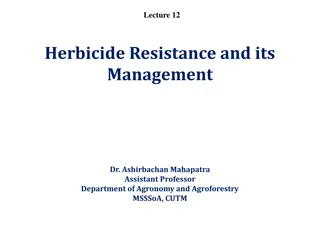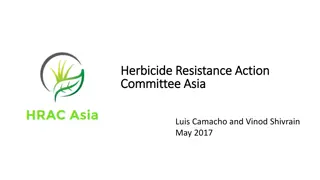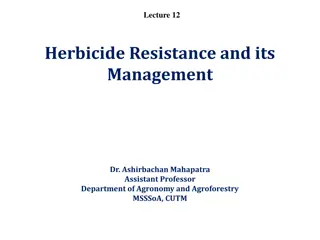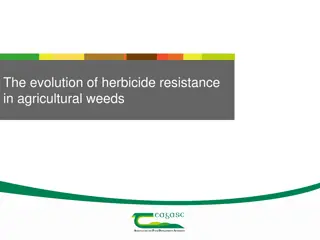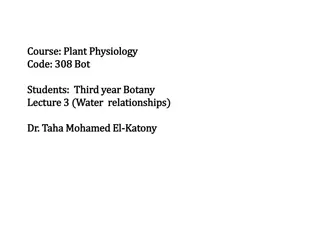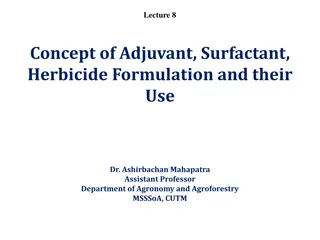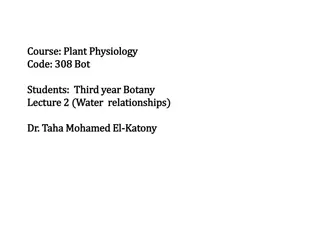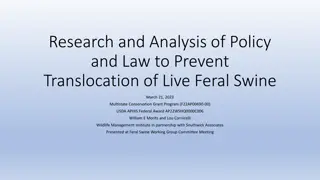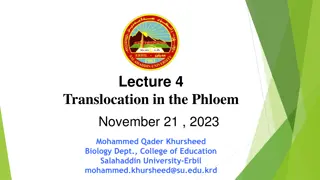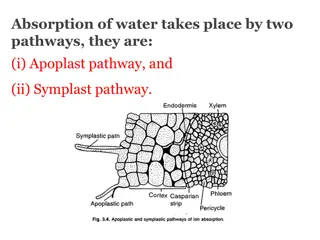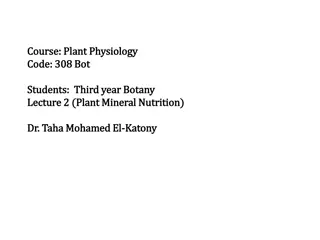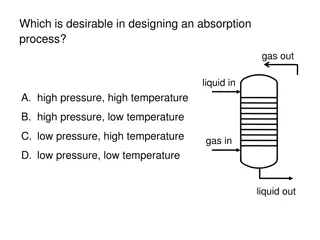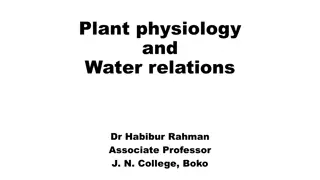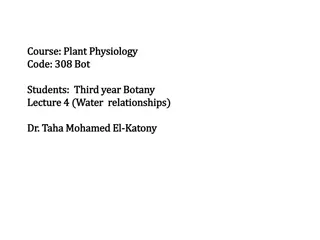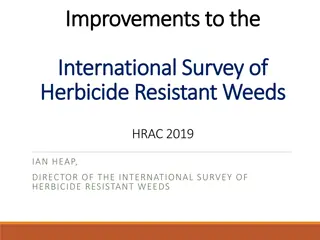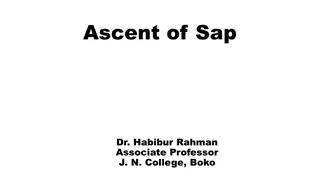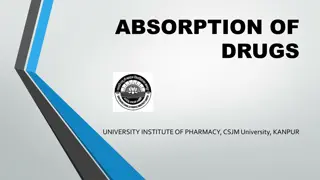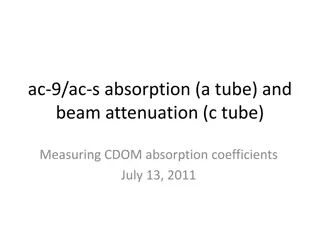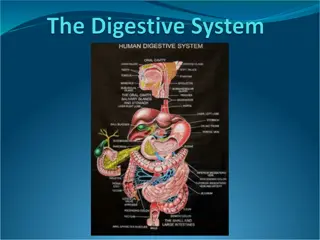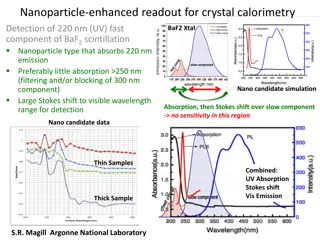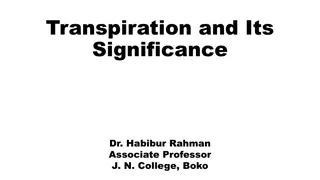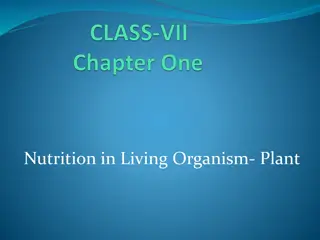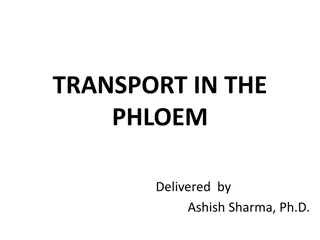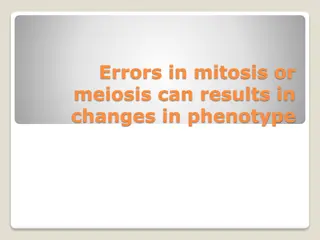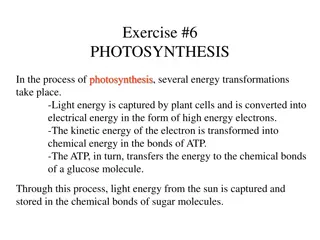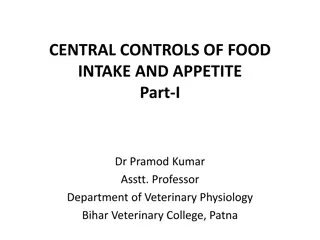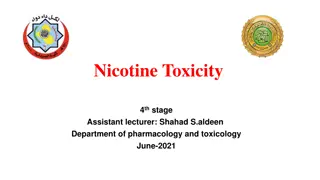Herbicide Absorption and Translocation Mechanisms in Plants
Herbicides need to be effectively absorbed and translocated within plants to interfere with physiological and biochemical processes. Soil-applied herbicides are absorbed by roots, shoots, and seeds through different mechanisms, while foliage-applied herbicides enter through the cuticle, stomata, and trichomes. Herbicides can move apoplastically or symplastically within the plant system, being translocated either through the vascular system or interconnecting cells. Understanding these absorption and translocation pathways is crucial for effective herbicide application in agriculture.
Download Presentation

Please find below an Image/Link to download the presentation.
The content on the website is provided AS IS for your information and personal use only. It may not be sold, licensed, or shared on other websites without obtaining consent from the author. Download presentation by click this link. If you encounter any issues during the download, it is possible that the publisher has removed the file from their server.
E N D
Presentation Transcript
Lecture 13 Transformation of Herbicide in Plant Dr. Ashirbachan Mahapatra Assistant Professor Department of Agronomy and Agroforestry MSSSoA, CUTM
To be effective the herbicide must be absorbed and translocated in adequate quantities to the site of action to interfere with the physiological and biochemical processes of plant. Absorption of soil applied herbicide The pathway and mechanism of herbicide absorption by roots is similar to that of nutrient absorption through active and passive mechanisim. A nonpolar herbicide can dissolve suberised casperian strip which separate cortex and still at endo-dermis and diffuse through it to reach the stele and move symplastically. However the polar herbicide move inwards with water along apoplast system. Soil applied herbicide are also absorbed by developing shoot and coleoptiles. Shoot entry is considered as the primary site of entry for herbicide like EPTC. Seeds absorbed herbicides through diffusion is independent of water absorption this process is depended on herbicide concentration and its solubility in water, Thus root, shoot,& seed are the major site of uptake of soil applied herbicides. Cross-section of plant root showing the various structures and expanded view of the Casparian strip and vascular stele
Absorption of foliage applied herbicide 1. Foliar penetration Post-emergence applied herbicide enter the plant system through foliage. The effect of herbicide depends on its ability to penetrate the cuticle which is the part of apoplast & protoplasm, which cover all the surface of symplast. Polar compound such as 2,4-D salt, PCP, TCA salt etc. are soluble in polar solvents & insoluble in non polar solvents. Non polar compound include 2,4-D acids & esters. They dissolve in non-polar solvents such as oils but not in water. Polar herbicide take the aqueous pathway.
2. Trichome and stomata penetration Trichome (leaf hair) are extension of epidermal cells which contain protoplasm. They play significant role on herbicide absorption. Stomatal leaf allow gaseous exchange. Aquaeous solutions don t penetrate stomata and hence addition of wetting agent necessary to improve spreading of herbicide soluation on leaf surface. Stomatal absorption is greater through lower than upper leaf surface due to more no of stomata, trichome, morphology and chemistry of cuticle and amount of wax present. 3. Penetration through stem The degree of herbicide penetration through stem surface depends on growth stage of plant. Penetration is rapid through young and immature stem. Herbicide entry through bark of woody plants is normally done by mechanical cuts or by injection. Diagram of the vascular system showing primary elements of the xylem and phloem
Herbicide translocation Herbicide absorbed into plant system moves either apolastically or symplasticaly. Apoplast refers to the system of non living inter connecting cells with air and water filled xylem elements. Symplast refers to the system of inter connected protoplasm with sieve tube. Soil applied herbicides They are absorbed by plant moves upward apoplastically in the transpiration system. Water deficits aids in rapid absorption and translocation. They are transported to action side along with water. Foliage applied herbicide Phloem and xylem are the main pathways of translocation. Herbicide move along with assimilates from leaves through phloem to all other developing part.
Factor affecting absorption and translocation Plant factor Plant factor such as branching habit, leaf surface, growth stage, crop &cultivar influence absorption and trans location of herbicide. Broad leaf weeds generally have open and horizontally branching habit which can retain spray droplets and easy surface coverage. Grasses foliage usually have rough surface hence non polar herbicides are effective against grasses. Waxy surface restrict herbicide entry. Addition of wetting agent is necessary for better spread of herbicide. Chemical factors High temperature affecting physiological and biochemical processes in the plant absorption and translocation of herbicide. High humidity facilitates free movement of herbicide. Rains immediately after herbicide application may wash off the spray deposit.
Soil factors Soil moisture stress affects permeability of root water and herbicide. Soil moisture stress also reduces entry and translocation of foliage applied herbicides. Most herbicide remain in ionic form at pH between 4.5 and 7.5. Soil organic mater and clay minerals influence movement, availability and absorption of herbicide. Chemical nature Herbicide concentration, pH of herbicide & its chemical structure affect herbicide absorption. Use of surfactant enhances the absorption of polar herbicides. Surfactants improve herbicide spray retention on foliage, penetration, absorption and translocation of post emergence herbicide



